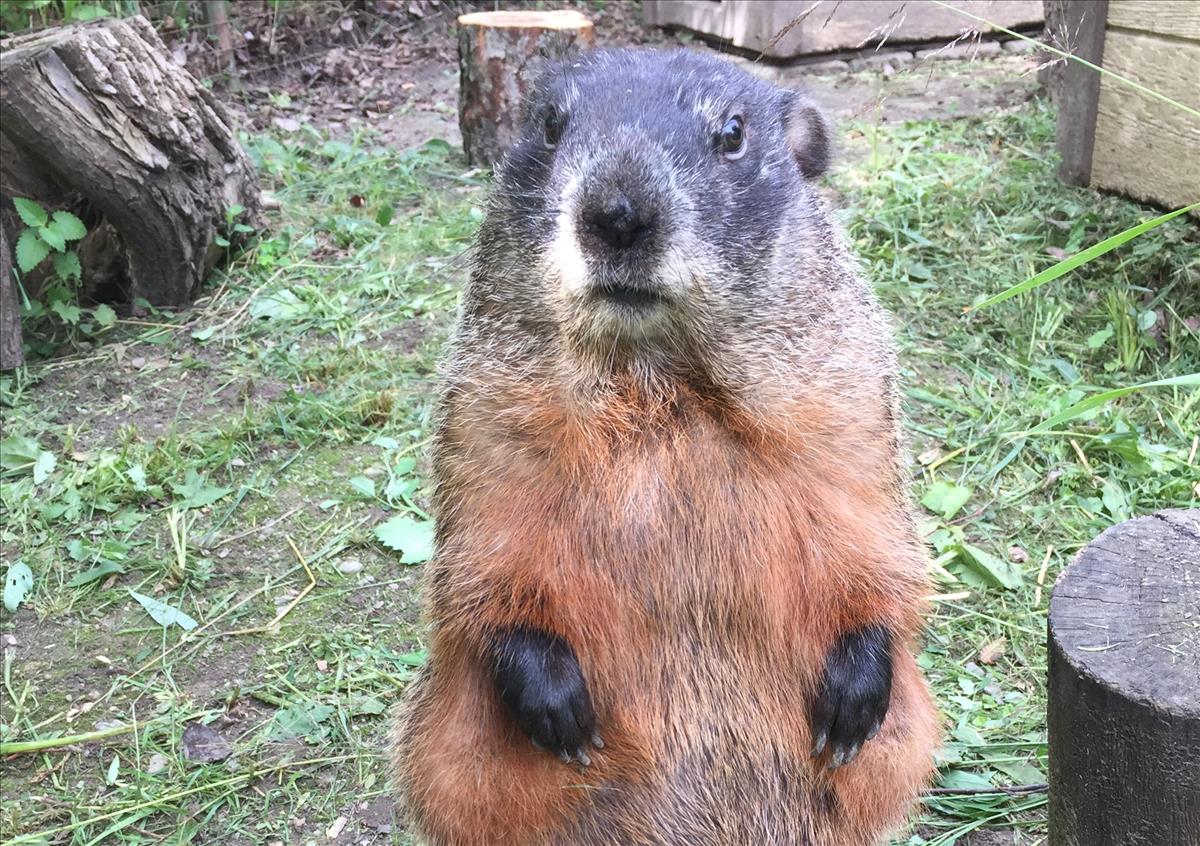Alerts
Please be advised that our bird aviaries are open!
Your Toronto Zoo is committed to the health and safety of the animals in our care. We take proactive steps to protect our birds from Avian Influenza which has been confirmed in a wild bird in southern Ontario, and some birds may still be off display.
Please note Splash Island is still closed and will not open until July due to unforeseen delays in construction. Please watch for updates on https://www.torontozoo.com/tz/splash or on our social media pages. Thank you!
Please note the following animals are currently not on display due to various reasons including Avian Bird Flu, and Covid-19 sensitivity:
- Flamingo, peacock, owl, bald eagle, and aviaries
- Some Kids Zoo Animals
- Cougar
- Moose
- Kangaroo walk through (kangaroos are still visible)
- Axolotl
We apologize for the inconvenience!


Mammal
Location at the Zoo:
Kids Zoo
Region: North America
Woodchuck
The woodchuck, or groundhog, is a member of the marmot family, which is a large group of ground-dwelling squirrels. It is the best known of the American marmots. There are six geographically defined subspecies of woodchucks varying slightly in colouration and size.The woodchuck has a thickset body, broad, flat head, very little neck, short rounded ears, short limbs, and tail. The dark-coloured, bushy tail is about one-fourth as long as the total body length, much shorter in comparison to other squirrels. Their hind feet have five well-developed digits; one of the five digits on the front feet is rudimentary and covered with a flat nail. All other toes have flattened curved claws suitable for digging. Females have four pairs of teats.
The dense woolly underfur of the back and sides of the woodchuck is somewhat obscured by longer, less dense, guard hairs. These guard hairs are banded with alternating dark and light colouring (bands usually yellowish to reddish brown, hairs tipped with white), giving this mammal a frosted appearance. The underfur of the woodchuck is gray with yellow tips, much paler from the dorsal area. The small, low ears are on top of a black-coloured head with small black eyes. The woodchuck is the largest sciurid in its geographic range.
Length: 45.7 - 65.4 cm.
Tails: 10.5 - 16.3 cm.
Weight: Males average 2.85 kg., but before hibernation can weigh up to 3.5 kg.
Females are slightly smaller and lighter in weight.
Conservation Status: IUCN

Distribution:
The six geographic subspecies of woodchuck occur over the northeastern United States, all of the Canadian provinces and territories (except Prince Edward Island), the Yukon, and central Alaska.Habitat:
With the deforestation of North America, and the cultivation of fields and pastures, the woodchuck has thrived. They prefer fields, fence rows, farmlands, as well as deciduous and coniferous woodlands.Diet:
Mainly herbivores. Eat mostly green vegetation such as clover, alfalfa, buttercups, dandelions, plantains, goldenrod, and asters. In early spring, before vegetation growth, they eat bark and twigs of trees such as sumac, cherry, and dogwood. They also eat garden crops such as corn, carrots, beans, beets, lettuce, cabbage, turnips, strawberries, and melons which makes them a pest to growers. They may eat insects and ground nesting young birds opportunistically.Reproduction:
Females may breed after 11 months of age, but usually at about two years. Males are sexually active on emerging from hibernation in the spring and may fight for partners. Gestation is 31 - 32 days and all young are born in May. Litters may be from one to eight with an average of four. The young are born naked, pink, blind, and helpless in a lined nest. They get short black hair after two weeks and start to crawl after three weeks. Their eyes open at day 26 and they soon start to eat green material. At five weeks they emerge from the den and play and romp around the entranceway. The young are weaned at about six weeks. They are usually forced to disperse in their first summer of life.Adaptation:
The woodchuck usually feeds during the day, around noon in the early spring, and early in the morning during hotter weather. It excavates two types of burrows for shelter; a hibernating den, which is commonly in woods or fence rows, and a summer den in a field. The burrow of an adult woodchuck may have two to five entrances and several chambers which are kept clean and often well padded with leaves. Faeces are buried in a blind tunnel or in the soft earth of the entranceways. The short, but powerful legs are well adapted for digging. It has a slow walk, but can run to its den when scared, giving a sharp whistle signifying danger, and putting up a strong defense with chattering teeth when challenged. Quick bursts of speed and diving down den entranceways keeps them safe from predators.They are true hibernators; they enter a prolonged state of torpor with lowered body processes. Heartbeat slows down from 100 beats per minute to as few as 15 beats per minute, body temperature drops from about 35 ˚C to 8 ˚C and respiration also decreases. It usually hibernates when it gets cold in November to the first mild spells in April. Females usually share their den with offspring over the winter. Woodchucks are usually solitary, but pairs may share a den during summer.
Woodchucks are very vocal, hence their common name of "whistle-pig". When alarmed, a woodchuck gives a loud, shrill whistle. Teeth grinding and chattering are common when woodchucks are cornered. Woodchucks have also been heard to bark, squeal, and whistle when fighting with other woodchucks. It has three anal glands, which look like nipples, and give off a musky odour, which is a method of communication or recognizing individuals. The woodchuck can swim, climb trees and sometimes use the tops of fence posts for lookouts.
Woodchuck incisors are ever-growing and are heavily constructed. The anterior tooth face is ivory or yellowish ivory in colour, lacking the dark yellow pigmentation of other rodents.